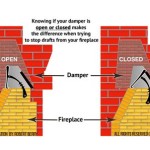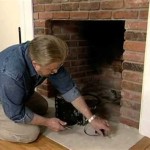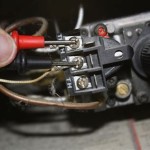Tiling Over a Painted Brick Fireplace: A Comprehensive Guide
Tiling over a painted brick fireplace can dramatically transform the aesthetic of a room, offering a modern or updated look while retaining the existing structure. However, successfully completing this project requires careful planning, proper surface preparation, and the use of appropriate materials. This article provides a detailed guide to tiling over a painted brick fireplace, covering essential steps and considerations to ensure a durable and visually appealing result.
Assessing the Suitability of the Brick Surface
Before commencing the tiling process, a thorough assessment of the existing painted brick fireplace is crucial. This assessment involves evaluating the structural integrity of the brick, the condition of the paint, and the overall suitability of the surface for tile adhesion. Any deficiencies identified during this stage must be addressed to prevent future problems such as tile cracking or detachment.
The first step is to inspect the brickwork for any signs of damage, such as cracks, spalling (flaking), or loose bricks. These issues must be repaired before tiling begins. Cracks should be filled with mortar or epoxy-based crack filler, ensuring the structural integrity of the underlying brick. Loose bricks should be carefully removed, cleaned of old mortar, and re-mortared into place. Ignoring these structural issues will compromise the stability of the tile installation.
The condition of the paint is equally important. Multiple layers of paint, or paint that is peeling or flaking, can hinder proper tile adhesion. The paint must be securely bonded to the brick surface. Conduct a test by scoring the paint with a utility knife in a grid pattern. Apply strong tape over the scored area and then pull it off abruptly. If the paint comes off with the tape, it indicates poor adhesion and needs to be addressed. Sandblasting, mechanical grinding, or chemical stripping may be necessary to remove poorly adhered paint. A stable, well-adhered paint surface is essential for proper thin-set mortar bonding.
Finally, consider the type of paint used on the brick. Oil-based paints create a slick, non-porous surface that is difficult for thin-set mortar to bond to. Latex paints are generally more porous and provide a better surface for adhesion, but they still require thorough preparation. If the type of paint is unknown, it is advisable to treat it as though it were oil-based and prepare the surface accordingly, ensuring maximum adhesion.
Surface Preparation: Ensuring Optimal Adhesion
Proper surface preparation is the cornerstone of a successful tile installation over painted brick. This process involves cleaning, roughening, and priming the surface to create a sound base for the thin-set mortar to adhere to. Neglecting these steps can result in tile failure and costly repairs.
The initial step in surface preparation is thorough cleaning. Remove any dirt, dust, grease, or debris from the painted brick surface. A strong detergent and a scrub brush can be used to clean the surface effectively. Rinse thoroughly with clean water to remove any detergent residue. Allow the surface to dry completely before proceeding to the next step. This cleaning process ensures that the subsequent roughening and priming steps are effective.
After cleaning, the painted surface needs to be roughened to create a mechanical bond for the thin-set mortar. Several methods can be used for this purpose. Sanding the surface with coarse-grit sandpaper (60-80 grit) is a common approach. This creates microscopic scratches that provide a surface for the mortar to grip. Alternatively, a wire brush or a grinding wheel can be used for more aggressive roughening, particularly if the paint is thick or glossy. Regardless of the method used, ensure that the entire painted surface is roughened evenly.
Once the surface is roughened, a primer specifically designed for use over non-porous surfaces should be applied. These primers, often referred to as bonding primers or adhesive promoters, create a chemical bridge between the painted surface and the thin-set mortar. Choose a primer that is compatible with the type of thin-set mortar being used. Follow the manufacturer's instructions for application, ensuring that the primer is applied evenly and allowed to dry completely before proceeding with the tile installation. A high-quality bonding primer is crucial for long-lasting tile adhesion.
Selecting the Right Materials and Techniques
Choosing the correct materials and employing proper tiling techniques are essential for achieving a durable and visually appealing tile installation over a painted brick fireplace. This involves selecting the appropriate thin-set mortar, tile type, grout, and applying them correctly.
The type of thin-set mortar is paramount. A modified thin-set mortar specifically designed for use over non-porous surfaces is necessary. These mortars contain polymers that enhance adhesion and flexibility, compensating for the differences in expansion and contraction between the brick, paint, and tile. Avoid using unmodified thin-set mortar, as it is unlikely to provide adequate adhesion to a painted surface. Consult with a knowledgeable tile retailer or manufacturer's specifications to select the appropriate thin-set mortar for the specific tile and substrate.
The choice of tile also impacts the overall success of the project. Consider the weight and size of the tiles. Larger and heavier tiles require a stronger thin-set mortar and may necessitate additional support to prevent slippage during installation. Natural stone tiles, such as slate or granite, are generally heavier than ceramic or porcelain tiles and may require specialized setting methods. Ensure that the fireplace structure can adequately support the weight of the chosen tiles. Additionally, selecting tiles that complement the existing decor and architectural style of the room enhances the overall aesthetic appeal.
Proper tiling techniques are crucial for achieving a professional-looking result. Apply the thin-set mortar evenly to the back of the tile using a notched trowel. The size and shape of the notches should correspond to the size and type of tile being used. Press the tile firmly into place, ensuring full contact with the thin-set mortar. Use tile spacers to maintain consistent grout lines. Periodically check the levelness of the tiles using a spirit level or laser level. Once the thin-set mortar has cured according to the manufacturer's instructions, remove the tile spacers and apply grout. Select a grout color that complements the tiles and clean any excess grout from the tile surface promptly. Seal the grout to protect it from staining and moisture penetration. These techniques will ensure a durable and visually pleasing tile installation.
When cutting tiles to fit around the firebox opening or other architectural details, utilize a wet saw or tile nippers for precise cuts. Dry-fitting the tiles before applying the thin-set mortar allows for adjustments and ensures a seamless fit. Pay close attention to detail and take your time to avoid errors. A well-executed tile installation will enhance the beauty and value of the fireplace.
Consider the environment around the fireplace when choosing materials. While the surface might not get as hot as the inside of the firebox, it is still exposed to heat fluctuations. Choose tiles and thin-set mortar specifically designed for fireplace surrounds if you use the fireplace regularly. These materials are designed to withstand higher temperatures and temperature changes without cracking or delaminating.
Expansion joints are also an important consideration. Areas where the tiled surface meets other building materials require expansion joints filled with a flexible sealant. These joints allow for movement caused by temperature fluctuations and prevent cracking. Typically, a silicone or polyurethane sealant is used in these expansion joints.
Grout selection should also consider the environment. Epoxy grout is more resistant to staining and water damage than cement-based grout, making it a good choice for areas that are frequently cleaned or exposed to moisture. However, epoxy grout can be more difficult to work with and may require specialized tools and techniques.
Finally, remember that safety is paramount. Always wear appropriate safety gear, including eye protection, gloves, and a dust mask, when working with tiling materials. Work in a well-ventilated area to avoid inhaling dust or fumes. Follow the manufacturer's instructions for all materials and tools. A safe and well-planned approach will help ensure a successful tiling project.

How To Tile Over A Painted Brick Fireplace The Morris Mansion

How To Tile Over A Painted Brick Fireplace The Morris Mansion

Renovating With A Tile Over Brick Fireplace Design
Slate Tile Over A Painted Brick Fireplace Ceramic Advice Forums John Bridge

How To Tile Over A Painted Brick Fireplace The Morris Mansion

How To Tile Over A Painted Brick Fireplace The Morris Mansion
First Project Cultured Stone Over Painted Brick Fireplace Ceramic Tile Advice Forums John Bridge

How To Tile Over A Painted Brick Fireplace The Morris Mansion

How To Tile Over A Painted Brick Fireplace The Morris Mansion

How To Tile A Brick Fireplace Jenna Kate At Home
Related Posts








